To know if you can modify your leased car, start by carefully reviewing your lease agreement. Look for clauses about alterations, as they detail what's allowed and what's not. Generally, minor changes like window tinting or removable seat covers are fine, but significant modifications might breach the lease terms. Always seek prior approval from your leasing company before making changes to avoid penalties. It's also wise to keep records of any modifications for inspections. Understanding the rules can save you from unexpected costs down the line. There's more to take into account, so exploring your options can definitely help you navigate this.
Key Takeaways
- Review your lease agreement for specific clauses regarding modifications to understand what is allowed and prohibited.
- Seek prior approval from your leasing company before making any changes to ensure compliance and avoid penalties.
- Document all modifications thoroughly, including receipts and photos, to maintain transparency and protect vehicle value.
- Focus on reversible modifications like window tinting or removable seat covers to avoid issues at lease return.
- Familiarize yourself with the definitions of normal wear and tear to understand potential charges at the end of your lease.
Understanding Lease Agreements
A lease agreement is your roadmap for renting a car, detailing the terms and conditions you must follow. It's a legally binding document that outlines the relationship between you, the lessee, and the leasing company.
One vital aspect of this agreement is its stance on modifications. Most lease contracts spell out whether you can make changes to the vehicle, often requiring prior written permission from the leasing company for any alterations.
Unauthorized modifications can lead to serious consequences, such as penalties, additional charges, or even voiding the warranty of the car upon its return. To avoid these issues, it's important to thoroughly review your lease agreement for specific clauses regarding modifications.
Some leases might allow temporary, non-damaging changes, while others may prohibit any alterations altogether.
Understanding the modification clauses in your lease agreement is fundamental. Violating these terms can result in significant financial repercussions, so be sure you know what's allowed before making any changes to the vehicle.
Types of Allowed Modifications
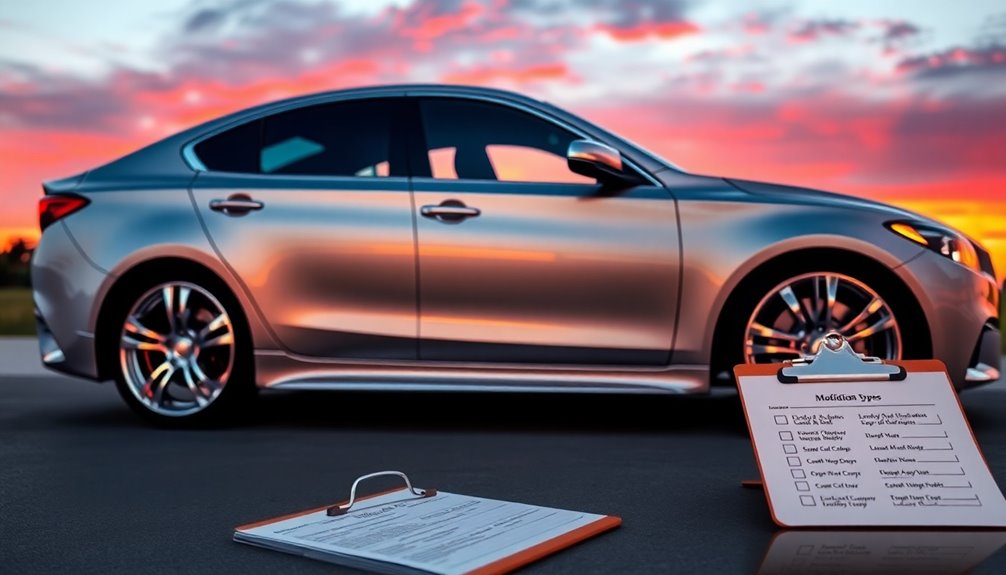
When it comes to modifying your leased car, there are several common options you might consider.
You'll find that many modifications are allowed, but others could lead to issues when it's time to return the vehicle.
Understanding which changes are reversible and compliant is key to ensuring you don't face penalties.
Common Allowed Modifications
Many leased vehicles allow for specific modifications that enhance your driving experience while keeping compliance in mind. Here are some common allowed modifications you can consider for your leased vehicle:
- Window Tinting: This enhances privacy and comfort, but be certain to comply with local laws regarding tint levels.
- Vehicle Wraps: You can change the color of your car without permanent paint alterations, making it a reversible option.
- Seat Covers: Installing seat covers is generally accepted, as they protect the upholstery and can be easily removed before you return the vehicle.
- Wheels and Tires: Upgrading your wheels and tires is permissible, but remember to reinstall the original tires before the lease ends.
Additionally, paint protection films and ceramic coatings are often allowed as they help preserve your vehicle's value without permanently altering the paint.
Temporary modifications, like non-damaging decals or accessories, are typically acceptable as long as they can be easily removed.
Always check your lease agreement to verify these common allowed modifications align with your specific terms.
Prohibited Modification Examples
Understanding what modifications are prohibited is vital for maintaining compliance with your lease agreement. Certain changes can lead to hefty penalties and even void the warranty.
For instance, modifying the exhaust system is typically off-limits, as it can impact pollution control systems and warranty coverage. Engine tuning, which reprograms your vehicle's computer for better performance, is also often forbidden and may void the warranty.
You should avoid significant alterations like turbocharging or supercharging, as these are easily detectable and could incur costly penalties when you return the car.
Additionally, upgrading your suspension system—whether raising or altering it—generally violates lease terms and requires you to restore it to the original condition before returning the vehicle.
Replacing original seats with aftermarket options is another common no-no; leasing companies usually prohibit this type of modification.
It's important to review your lease agreement carefully to guarantee you steer clear of these prohibited modifications. By doing so, you'll protect yourself from unexpected charges and maintain the integrity of your lease throughout the term.
Importance of Reversibility
Reversibility is key when it comes to modifying a leased car, as it helps you avoid penalties and maintain compliance with your lease agreement.
Leasing companies generally prefer modifications that can be easily undone. By focusing on reversible modifications, you can enjoy personalizing your vehicle without worrying about costly repercussions.
Here are some types of allowed modifications that are easily reversible:
- Wheels and Tires: Swap out the original wheels for new ones, but keep the originals to reinstall before returning the car.
- Exterior Styling Kits: Use kits that adhere with OEM mounting points or 3M tape, allowing for easy removal without damage.
- Interior Accessories: Add items like carbon trims or seat covers that can be removed later, leaving no permanent changes.
- Vinyl Wraps: Protect your car's paint with high-quality wraps that can be removed at the end of your lease without harm.
Common Prohibited Modifications
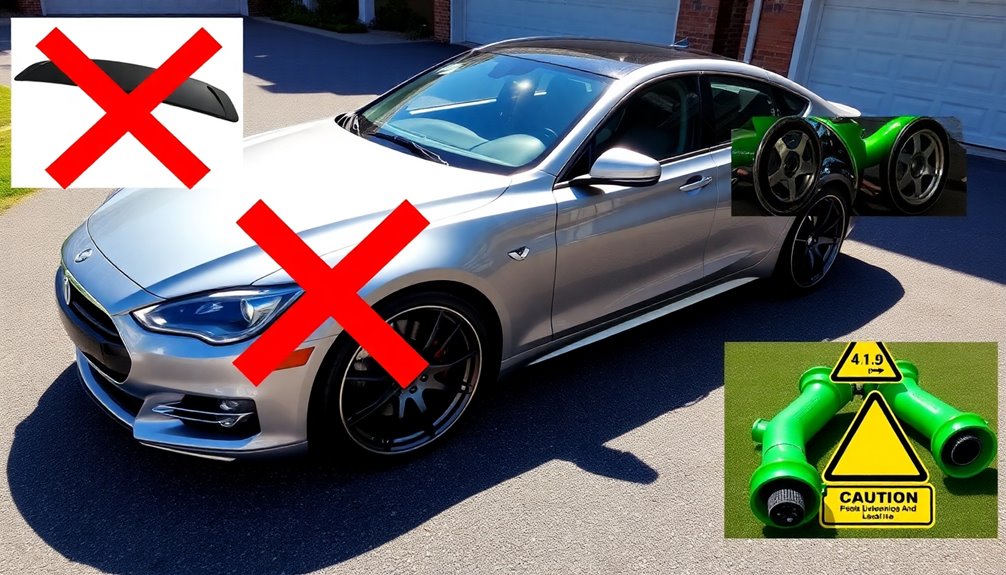
When it comes to leasing a car, knowing which modifications are prohibited is essential to avoid penalties. Many changes can jeopardize your warranty and lead to costly consequences at the end of the lease.
For instance, altering the exhaust system can affect emissions controls, risking warranty voiding. Engine tuning, such as reprogramming the vehicle's ECU for performance, is typically off-limits under lease agreements and can also void your warranty.
Significant modifications like turbocharging or supercharging are easily detectable and may require you to restore the vehicle to its original state, incurring additional costs. Alterations to the suspension system, like raising or modifying the height, violate leasing terms and can lead to hefty penalties.
Furthermore, swapping out original seats for aftermarket options is generally not allowed. These unauthorized modifications can trigger penalties upon lease return, leaving you with unexpected financial burdens.
Always remember to keep your vehicle as close to its original condition as possible to maintain compliance with the lease agreement and protect your warranty.
Importance of Seeking Permission

Before diving into any modifications, it's vital to reach out to your leasing company for clarity on their policies. Each leasing company has unique requirements, and understanding these can save you from unexpected fees or penalties later on.
Seeking permission not only clarifies what modifications are allowed but also guarantees you stay compliant with their specific guidelines.
Here are four key reasons why seeking permission is essential:
- Avoid Penalties: Failing to get approval can lead to fees during the end-of-lease inspection, impacting your budget.
- Understand Limitations: Each company has different rules; knowing these helps you avoid misunderstandings regarding return conditions.
- Document Changes: Keeping records of approved modifications, including correspondence, protects you in case of disputes.
- Maintain Vehicle Value: Certain modifications can decrease a vehicle's value, and understanding what's acceptable can help maintain its worth.
Additionally, understanding the most common automotive repairs can help you make better decisions about what modifications are feasible without jeopardizing your lease agreement and ensuring vehicle reliability.
Taking the time to seek permission for modifications makes your leasing experience smoother and protects you from unnecessary complications down the road.
Don't skip this important step!
Reversible Modifications Explained
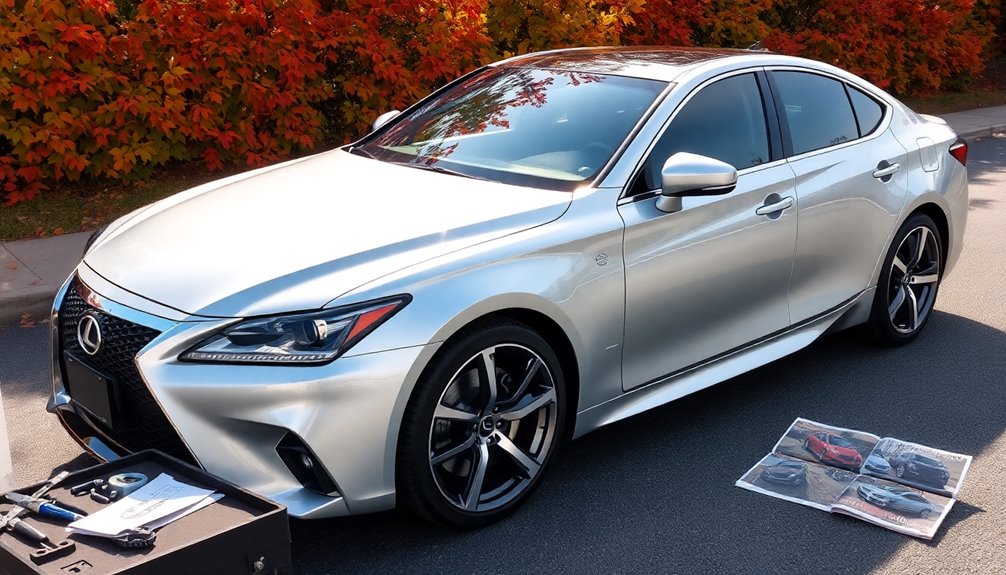
When you think about modifying your leased car, focusing on reversible modifications is key.
These changes, like window tinting or vinyl wraps, can easily be removed without damaging the vehicle, keeping you in line with lease terms.
Importance of Reversibility
Reversible modifications are key when it comes to customizing your leased car without running afoul of lease agreements. Leasing companies prefer these types of changes since they can be easily removed, ensuring you comply with the terms of your lease when it's time for returning the vehicle.
Focusing on reversibility not only helps you avoid penalties but also keeps your vehicle in good standing for inspection.
Here are four reasons why prioritizing reversible modifications is important:
- Compliance: Reversible modifications align with leasing policies, preventing potential penalties. Staying within the mileage limits is essential to avoid additional charges.
- Easy Removal: Items like wheel upgrades and exterior styling kits can be swapped back without damage.
- Interior Options: Accessories like carbon trims and removable seat covers keep the original upholstery intact.
- Documentation: Keeping records of reversible modifications and their removal process promotes transparency with your leasing company.
Additionally, opting for reversible modifications can also help maintain the vehicle's residual value at the end of the lease, which is a critical factor in lease agreements.
Common Reversible Modifications
Exploring common reversible modifications can greatly enhance your leased car's style and functionality while keeping you in line with lease agreements. Here are some popular options to evaluate:
| Modification | Benefits | Reversibility |
|---|---|---|
| Window Tinting | Enhances privacy and comfort | Can be removed without damage |
| Vinyl Wraps | Temporary color change, protects paint | Easily peeled off at lease end |
| Upgraded Wheels/Tires | Improved handling and fuel economy | Original tires must be reinstalled |
| Removable Seat Covers | Protects upholstery and modifies interior | Simple to take off before returning |
These common reversible modifications allow you to personalize your vehicle without risking penalties. For instance, window tinting not only adds a sleek look but can also keep your cabin cooler. Additionally, budgeting for car expenses can help you manage costs associated with modifications. Similarly, vinyl wraps provide a unique aesthetic while shielding your car's original paint from wear. Upgrading wheels and tires can enhance performance; just remember to save the originals for the end of your lease. Furthermore, considering tax-advantaged retirement savings accounts can help you allocate funds for potential future car upgrades. Finally, removable seat covers offer both protection and style, ensuring you leave the car in excellent condition when it's time to return it. Moreover, understanding employer-sponsored retirement accounts can provide you with better financial stability while you enjoy your modifications.
Compliance With Lease Terms
Understanding the importance of compliance with lease terms is key before making any modifications to your leased car. Many lease agreements have specific clauses that require you to get prior approval from the leasing company. Ignoring these requirements can lead to penalties or additional charges.
To guarantee compliance, consider the following guidelines for reversible modifications:
- Review Your Lease Agreement: Check for any clauses about modifications to avoid unauthorized changes.
- Choose Reversible Options: Opt for modifications that can be easily removed, like window tinting or vinyl wraps.
- Document Everything: Keep receipts and notes on when modifications were made, as this may be needed during the end-of-lease inspection.
- Consult the Leasing Company: If in doubt, reach out to your leasing company for clarification on what modifications are acceptable.
Documenting Your Changes
When you make modifications to your leased car, it's vital to document every detail carefully. Start by keeping detailed records of all changes, including what you modified, when you did it, and any relevant invoices or receipts. This will help you track your investment and provide proof of your modifications if needed.
If you obtained written permission from the leasing company before making any changes, document that as well. This can help guarantee compliance with lease terms and protect you from any potential issues later on.
Additionally, take photos of your vehicle before and after modifications. These images serve as visual evidence of the condition of your leased car, which can be invaluable during the lease return process.
Don't forget to maintain a log of any maintenance or repairs related to the modifications. This clarity can be significant in understanding how the changes impacted the car's overall condition.
Consequences of Unauthorized Modifications
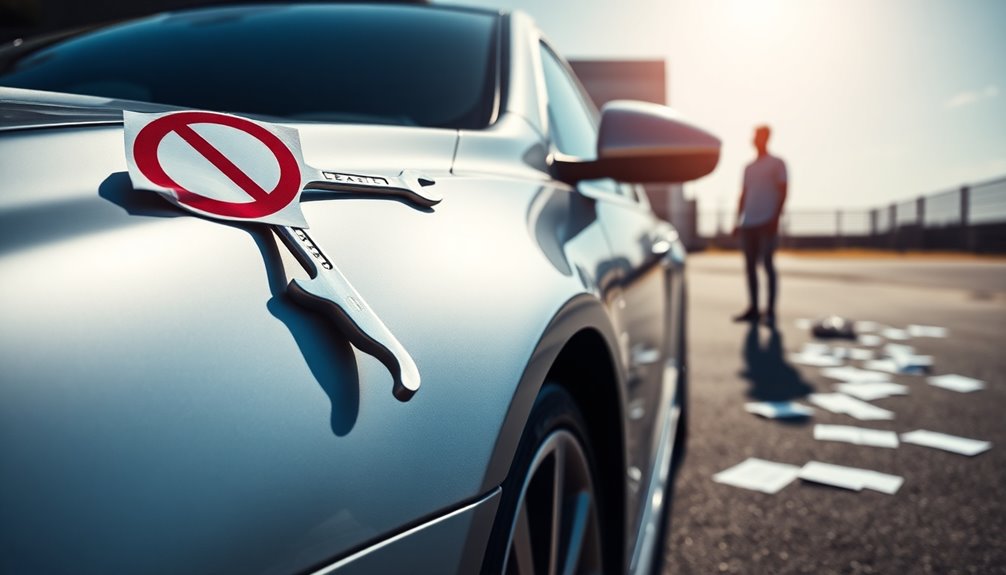
Unauthorized modifications to your leased vehicle can lead to serious consequences that may affect your finances and vehicle condition. If you decide to make changes without permission, you could face several penalties upon return.
Here are some key consequences to evaluate:
- Diminished Vehicle Value: Unauthorized modifications can lower the vehicle's resale value, leading to charges when you return it.
- Restoration Fees: Leasing companies often impose fees for repairs needed to restore the car to its original condition if modifications violate your lease terms.
- Warranty Issues: Changes that void the manufacturer's warranty may result in costly repairs that you'll have to pay for if damage occurs.
- Inspection Costs: During end-of-lease inspections, any unauthorized modifications will be assessed. You may need to remove these changes, which could incur additional costs.
Being aware of these consequences can help you avoid unnecessary financial burdens.
Always check your lease agreement and think twice before making any modifications that could complicate your lease return process.
End-of-Lease Inspection Process

How can you prepare for the end-of-lease inspection process?
First, understand that the inspection evaluates your vehicle's exterior and interior for damages beyond normal wear and tear. If there are issues, you might face additional charges.
Make sure to check your mileage as well; exceeding the agreed limit can lead to extra fees.
Inspectors will also assess the condition of tires and wheels. If they find any damage, you're responsible for replacements, so it's wise to inspect them beforehand.
If you've modified a leased car in any way, be prepared to revert those changes before you return the vehicle. Unauthorized modifications can affect the car's value, and the inspectors will look closely for them.
Keeping detailed documentation of any modifications or repairs during the lease term can help clarify the vehicle's condition during the inspection. This can also reassure you that everything is in order.
Alternatives to Modifying
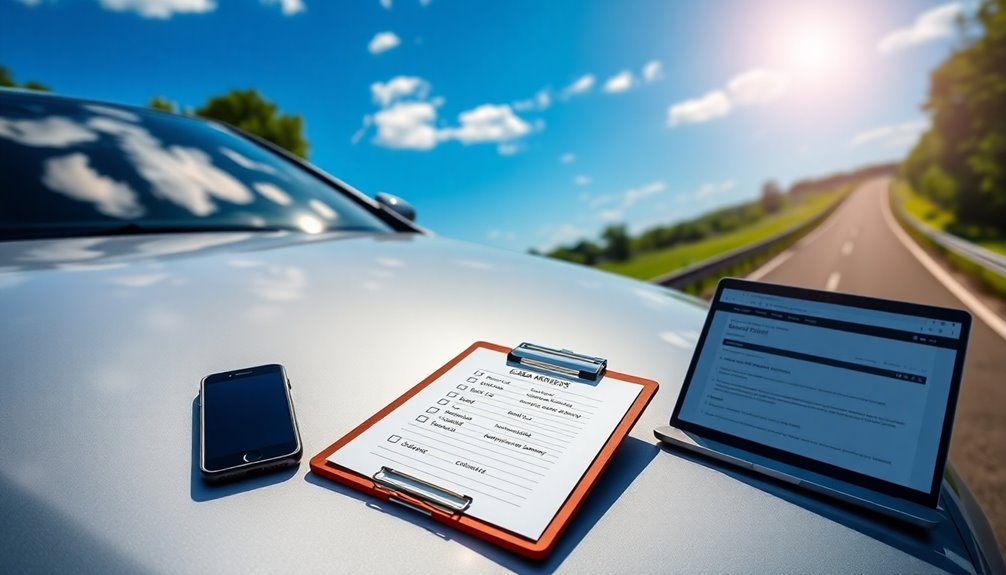
Returning a leased vehicle can be stressful, especially if you've thought about modifications. Instead of making changes to your leased car, consider some alternatives that keep you within lease terms while still enhancing your driving experience.
Here are a few options:
- Lease a Model with Desired Features: Look for a vehicle that already includes the modifications you want, saving you the hassle of changes.
- Aftermarket Options: Explore easily removable accessories that can be added during your lease term. Just make sure you can take them off before returning the vehicle.
- Temporary Accessories: Use removable seat covers or floor mats to enhance comfort and style without altering the car's original condition.
- Purchase at Lease End: If you love your leased vehicle, consider buying it at the end of the lease term. This gives you the flexibility to make any modifications without restrictions.
Preparing for Vehicle Return

Preparing for the return of your leased vehicle is essential to secure a smooth handover and avoid unexpected costs. Start by reviewing your lease agreement to verify that any modifications you made comply with its terms. If you've altered the vehicle in any way, document these changes, including dates and receipts, as this information may be needed during the inspection process.
Next, conduct a thorough inspection of the vehicle. Look for any damages that go beyond normal wear and tear, as these could lead to additional charges when you return the vehicle. If you've made unauthorized modifications, revert them to restore the vehicle to its original condition before the vehicle return. Leasing companies usually require this step.
Lastly, review the end-of-lease inspection checklist provided by your leasing company. Familiarizing yourself with the specific criteria will help you prepare adequately for the return.
Frequently Asked Questions
When You Lease a Car, Can You Modify It?
When you lease a car, you might wonder if you can modify it. The short answer is, it depends on your lease agreement.
Some modifications are allowed, but others could lead to penalties or void your warranty.
Temporary changes like window tinting are usually fine, but performance upgrades often require written permission.
Always check your lease terms and document any approved modifications to avoid issues during the return process.
What Can You Not Do With a Leased Car?
When it comes to leased cars, treating them like your own is like inviting a guest to your house and then redecorating.
You can't make significant modifications, like altering the engine or exhaust system, as these often violate the lease agreement.
Upgrading the suspension or replacing seats with aftermarket options is also off-limits.
If you do, you'll face restoration costs or penalties when it's time to return the vehicle.
Can I Modify the Exhaust on a Leased Car?
You typically can't modify the exhaust on a leased car.
Lease agreements usually prohibit such changes, as they can affect the vehicle's warranty and emissions controls.
If you decide to proceed anyway, you risk penalties or extra charges when your lease ends.
It's best to check your lease terms and get written permission from the leasing company to avoid costly repercussions.
Returning the car in its original condition is usually required.
Can You Modify the Suspension on a Leased Car?
You typically can't modify the suspension on your leased car.
Lease agreements usually prohibit significant alterations that might affect performance or safety. If you change the suspension, you risk penalties or additional charges when returning the vehicle.
It's essential to review your lease terms and get written permission from your leasing company before considering any modifications.
Restoring the car to its original condition may also be necessary before the end-of-lease inspection.
Conclusion
In the journey of leasing, knowing when to stay the course or take a detour is key. Think of your car as a canvas; every brushstroke matters. Before making any changes, check your lease terms and seek permission. Keep your modifications reversible, like a fleeting sunset that you can watch fade away. As you prepare to return your vehicle, remember: respecting the rules keeps your ride smooth and stress-free, allowing you to enjoy the road ahead.










